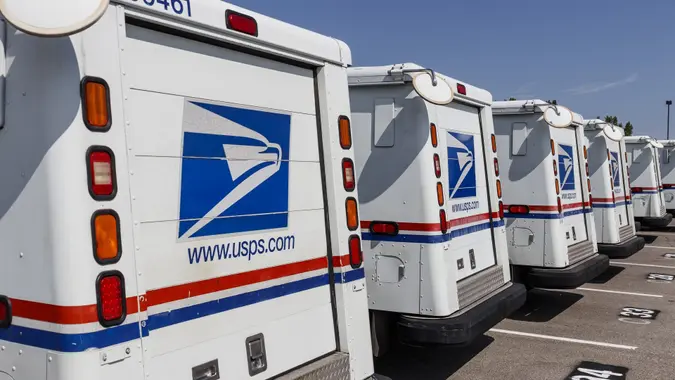

GOBankingRates' editorial team is committed to bringing you unbiased reviews and information. We use data-driven methodologies to evaluate financial products and services - our reviews and ratings are not influenced by advertisers. You can read more about our editorial guidelines and our products and services review methodology.
20 Years
Helping You Live Richer
Reviewed
by Experts
Trusted by
Millions of Readers
U.S. Postal Service money orders have been around for a long time. The USPS introduced them in 1864 to provide a safe way for soldiers and others to send money over long distances. Money orders have stood the test of time because they are an affordable and safe alternative to cash and checks. Plus, they do not have an expiration date.
To purchase a USPS money order, visit any U.S. post office location. You might also be able to buy a money order from a rural USPS carrier or a contract postal unit.
Money order fees will vary depending on the amount of the money order and whether you are sending it domestically, internationally or to a military address. Here’s the breakdown.
Postal military money orders, which you must purchase at military facilities, are $0.65 each, no matter the amount.
When you purchase a money order from the USPS, only the dollar amount is printed on it. You must write in the remaining fields. Most importantly, fill out the “Pay to” and “From” portions of the money order as soon as you purchase it. If you leave these fields blank, anyone can fill them in and cash the money order and you will not be eligible for a refund.
According to the USPS, you should fill out the money order in front of the postal associate at the time of purchase. Filling out a USPS money order is similar to writing a check, which you can do in a few quick steps:
Some money orders require your signature, like writing a check. However, you’re not required to sign the front of a USPS money order. Don’t sign the back, either. The payee endorses the back to deposit or cash it.
Be sure to keep the receipt for your money order so you can check its status or request a refund if it is lost or stolen.
USPS money order purchase limits vary depending on whether you are purchasing a domestic or international money order and are as follows:
You can purchase as many money orders as you want at one time. However, if you purchase more than $3,000 in money orders at one time or during the span of one day, you’ll have to fill out a Funds Transaction Report and show your ID.
Get the latest news on investing, money, and more with our free newsletter.
By subscribing, you agree to our Terms of Use and Privacy Policy. Unsubscribe at any time.

You're now subscribed to our newsletter. Check your inbox for more details.

You can’t use a credit card or a check to pay for a money order. The acceptable forms of payment when purchasing a money order include:
There is no significant difference between a USPS money order and other money orders issued by a financial institution or a service such as Western Union. Regardless of where you buy them, all money orders work the same way as a form of payment that can be cashed or deposited. However, the purchase fee is a notable difference between USPS and other money orders. A domestic USPS money order costs $2 or $2.90, depending on the amount. A money order from Wells Fargo Bank has a $5 fee regardless of the amount. The maximum fee for a money order at Walmart is $1. If you purchase money orders frequently, finding a low-fee option in your area is worth it.
Another difference between a USPS money order and a regular money order is that you can cash a USPS money order at the post office for free. If you send a USPS money order to an individual, they should have no problem cashing it at any post office if they have proper identification. However, they can also cash them at some banks and stores.
Yes, you can send international postal money orders via the following services:
You can track a USPS money order using the Postal Service’s “Check Money Order Status” tool. You’ll need the following information from the money order:
Unfortunately, as with many forms of payment, fraud can occur. To determine whether a USPS money order you have received is real, call the money order verification system at 866-459-7822.
To report money order fraud, contact the U.S. Postal Inspection Service at 877-876-2455.
The post office might not be the cheapest place to get a money order, but it is convenient since you can go to any post office to buy or cash one When purchasing a USPS money order, fill it out immediately in case it is lost or stolen. Also, keep your receipt until you know the recipient has successfully cashed or deposited the money order. You’ll need the receipt to track the money order or request a refund if there is a problem.
Andrea Norris contributed to the reporting for this article.
View SourcesOur in-house research team and on-site financial experts work together to create content that’s accurate, impartial, and up to date. We fact-check every single statistic, quote and fact using trusted primary resources to make sure the information we provide is correct. You can learn more about GOBankingRates’ processes and standards in our editorial policy.